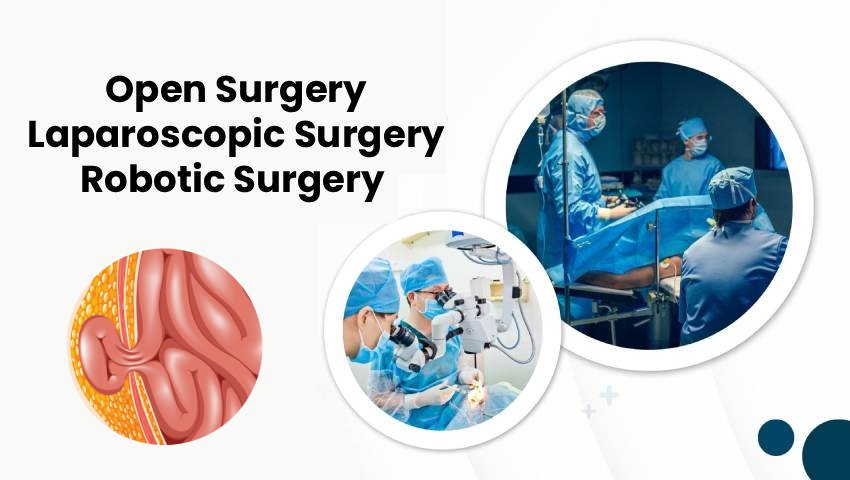Hernias are a common health problem in India, especially among people who do heavy physical work or have weak abdominal muscles. A hernia happens when an organ or tissue pushes through a weak spot in the muscles. Surgery is the only permanent solution for hernia. But today, patients have many surgical options—Open Surgery, Laparoscopic Surgery, and Robotic Surgery. Each of these methods has its own benefits and limitations. As a patient, it is important to understand how they are different and which one suits your condition best. Dr. Srivatsan Gurumurthy, a highly experienced Best Hernia Surgeon in Chennai, explains these techniques based on his expertise in both laparoscopic and robotic hernia surgeries.
What is Open Hernia Surgery?
Open surgery is the oldest and most traditional method for hernia repair. It involves a single larger cut made over the hernia site. The surgeon pushes back the bulging tissue into place, stitches the muscle wall, and often places a mesh to strengthen the area. Open surgery is usually recommended for:
- Large or complex hernias
- Recurrent hernias
- Emergency hernia cases (strangulated or obstructed hernia)
It is done under spinal or general anesthesia. Recovery time is longer, and there is a visible scar. However, open surgery is widely available & less expensive than advanced techniques.
What is Laparoscopic Hernia Surgery?
Laparoscopic surgery, also known as keyhole surgery, is a minimally invasive method. Instead of one large cut, the surgeon makes 2 to 3 small incisions. A camera (laparoscope) and special instruments are inserted through these cuts to repair the hernia. In this method, mesh is placed behind the muscle wall to give more support and reduce the chance of recurrence.
Advantages of Laparoscopic Surgery:
- Smaller cuts and minimal scarring
- Less pain after surgery
- Faster recovery
- Lower risk of wound infection
- Can repair both sides (in bilateral hernias) in a single surgery
Laparoscopic hernia surgery requires experience and training. Not all hospitals or surgeons are equipped for this technique. Dr. Srivatsan Gurumurthy is a leading laparoscopic hernia surgeon in Chennai, with advanced training in minimally invasive methods.
What is Robotic Hernia Surgery?
Robotic hernia surgery is the most advanced technique available today. It is similar to laparoscopic surgery but performed with the help of a robotic surgical system like the Da Vinci robot.In this method, the surgeon controls robotic arms from a console. The robotic system offers a 3D view, better precision, and more flexibility in movement. This is especially useful for complex or large hernias. Dr. Srivatsan is one of the few surgeons in Chennai who is trained in robotic hernia surgery. He uses this technique for faster recovery, minimal pain, and long-term results.
Comparison of All Three Methods:
Let us compare Open, Laparoscopic, and Robotic surgeries for hernia on important factors:
Cut Size and Scar:
- Open Surgery: Large cut, visible scar
- Laparoscopic Surgery: Small cuts, minimal scarring
- Robotic Surgery: Smallest and most precise cuts
Pain and Recovery:
- Open surgery causes more pain and takes longer to heal
- Laparoscopic and Robotic surgeries cause less pain and quicker recovery
- Robotic method has the least tissue damage
Hospital Stay:
- Open Surgery: 3–5 days
- Laparoscopic: 1–2 days
- Robotic: Often discharged the next day
Cost of Surgery:
- Open surgery is the least expensive
- Laparoscopic is moderately priced
- Robotic surgery is more costly but gives better comfort and faster return to normal life
Risk of Infection and Recurrence:
- Risk of infection is higher in open surgery
- Lower in laparoscopic and robotic
- Robotic surgery offers best precision, so recurrence is less likely if done by a skilled surgeon
Which Surgery Should You Choose?
There is no “one-size-fits-all” answer. The choice of surgery depends on:
- Type and size of hernia
- Age and overall health of the patient
- Whether it is a first-time or recurrent hernia
- Availability of technology and skilled surgeon
- Your budget and personal preference
For example, a young patient with a small inguinal hernia may do well with laparoscopic surgery. An elderly patient with a large incisional hernia may need open surgery. Complex recurrent cases benefit most from robotic surgery. That’s why you must consult a specialist like Dr. Srivatsan Gurumurthy, who can guide you on the best option based on your individual case.
Why Choose Dr. Srivatsan Gurumurthy?
Dr. Srivatsan is a well-known robotic and laparoscopic hernia surgeon in Chennai with over 17 years of experience. He practices at GEM Hospital, Perungudi, which is known for advanced gastrointestinal care. His training includes:
- MBBS from Chengalpattu Medical College (2005)
- MS in General Surgery from Stanley Medical College (2010)
- DNB in GI Surgery from the National Board (2015)
- FMAS and FMIAS certifications in advanced laparoscopic surgery
- Specialised training in Da Vinci Robotic Surgery
He has performed thousands of hernia surgeries using all three techniques and helps patients recover faster with fewer complications.
Final Thoughts:
All three techniques—Open, Laparoscopic, and Robotic Surgery—are effective in treating hernia. The key is to choose the right approach based on your specific condition. If you are looking for a safe and advanced hernia treatment in Chennai, consult Dr. Srivatsan Gurumurthy. Whether you need open, laparoscopic or robotic surgery, he will recommend the most suitable option and ensure personal care throughout your recovery.





Comments